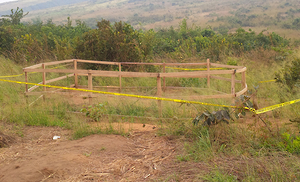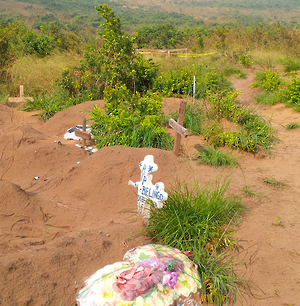DR Congo: Exhume Mass Grave
Families Suspect It May Contain Security Force Victims
Democratic Republic of Congo authorities should promptly and properly exhume a mass grave that may contain the bodies of people forcibly disappeared or executed by Congolese security forces, Human Rights Watch said on June 8. On June 5, 2015, the families of 34 victims filed a public complaint with Congo’s national prosecutor requesting justice and the exhumation of the mass grave in Maluku, a rural area about 80 kilometers from the capital, Kinshasa.

Mass gravesite on the edge of the Fula-Fula cemetery in Maluku, on the outskirts of Kinshasa, capital of the Democratic Republic of Congo, where government officials say 421 bodies were buried during the early morning hours of March 19, 2015.
Local residents, opposition leaders, the United Nations peacekeeping mission in Congo (MONUSCO), and human rights groups, including Human Rights Watch, have raised concerns about a March 19 nighttime mass burial, in which government security forces participated, on the edge of Maluku’s Fula-Fula cemetery. The government has neither exhumed the gravesite nor revealed the identities of those buried there.

The edge of the Fula-Fula cemetery in Maluku, on the outskirts of Kinshasa, capital of the Democratic Republic of Congo, where government officials say 421 bodies were buried during the early morning hours of March 19, 2015.
“Two months since the discovery of the mass grave in Maluku, Congolese authorities have yet to provide clarity about who is buried there,” said Ida Sawyer, senior Africa researcher at Human Rights Watch. “Families of victims of human rights abuses have a right to know if their loved ones are among those buried in the grave.”
The authorities should immediately conduct a proper exhumation with the assistance of international experts, Human Rights Watch said. Foreign governments and the UN should support the investigation, including by providing forensics experts to help exhume the bodies and conduct DNA testing.
The unusual circumstances of the burial heighten concerns that the cemetery is being used to hide victims of government abuses, Human Rights Watch said. A woman from Maluku told Human Rights Watch that at about 2 a.m. on March 19, as she was walking home from a night vigil at her church, she saw a large dump truck enter the Fula-Fula cemetery. She said that more than a dozen men in military uniform were in the truck, as well as some in civilian clothes, and that a large white tarpaulin covered the truck’s contents.
A man who has a farm next to the cemetery said that at about 5 a.m. on March 19 he saw a large dump truck and people shoveling soil at the edge of the cemetery. When returning to his home that morning, men he believed were intelligence officers stopped him and asked him what he had seen at the cemetery. In the days and weeks that followed, unidentified men came to his home on at least four occasions and later came to his workplace and accused him of having “divulged the secret” about the mass grave. In early April, he received a call from an unidentified man who said: “You, just wait. You’re going to die.”
The discovery of the mass grave came in the context of increasing political tensions and a worsening crackdown on activists, political leaders, and others who have opposed attempts to allow Congo’s President Joseph Kabila to stay in power beyond late 2016, when his constitutionally mandated two-term limit ends.
On April 3, Evariste Boshab, Congo’s vice prime minister and interior minister, announced during a meeting with other senior government and security officials, Human Rights Watch, a MONUSCO representative, and Congolese journalists, that 421 bodies had been buried in a mass grave. He said the burial was a “normal procedure” and that the bodies included indigents whose families could not afford burial, unidentified bodies, and stillborn babies.
But Congolese Red Cross officials and hospital and morgue employees told Human Rights Watch the burial was not normal procedure. They said it is common practice for stillborn babies to be buried within a day or two, often in designated areas in hospital grounds, or by the families themselves in cemeteries. Indigents and unidentified bodies are usually buried during the day in low-cost caskets in a dignified burial in one of Kinshasa’s cemeteries, if no one claims the body following a public announcement.
Boshab said in the meeting that if there were any doubts about who was buried in the site, the bodies would be exhumed. Justice Minister Alexis Thambwe Mwamba, also present at the meeting, echoed Boshab’s commitment to exhume the bodies if there were any remaining doubts.
Ghislain Mwehu Kahozi, a public prosecutor who is leading a judicial investigation into the mass grave, told Human Rights Watch on May 11 that 12 families of people allegedly killed or forcibly disappeared by security forces in 2013 and 2014 had filed individual legal complaints calling for an exhumation of the bodies. He said his team was working to confirm the allegations before making a decision.
The prosecutor said the site was well protected. However, Human Rights Watch visited the site on the afternoon of May 11, and found the area deserted and unguarded. The site was marked off with rudimentary wooden fencing and police tape, unlikely to deter anyone intent on tampering with evidence.
“The growing number of legal complaints from family members whose loved ones have disappeared highlights the urgency of exhuming the mass grave,” Sawyer said. “The Congolese government should make good on its promise to exhume the bodies and properly protect the grave until that occurs.”
The suspicious death of a nurse in charge of one of Kinshasa’s morgues on the night of the mass burial raises further concerns, Human Rights Watch said. On the evening of March 18, Claude Kakese, who had studied forensics and was in charge of the morgue at Clinique Ngaliema, one of Kinshasa’s main hospitals, died in suspicious circumstances in a purported traffic accident a few kilometers past Ndjili airport, on the road to Maluku. One of his colleagues told Human Rights Watch that Kakese had a reputation for providing accurate information about the cause of death of bodies brought to the morgues in Kinshasa. His family believes his death was linked to the mass burial at Maluku.
The following day, a local TV station reported that Kakese had died in a drunk driving accident with a whiskey bottle found in his car. A witness who arrived at the scene shortly after the accident told Human Rights Watch that Republican Guard soldiers surrounded Kakese’s car and there were no alcohol bottles. The witness said that the soldiers gave contradictory stories of what caused the accident. The witness saw Kakese’s body lying across the two front seats with what looked like a bullet wound under his chin. Kakese’s family members said they saw a similar wound when they saw his body at the morgue.
Congolese authorities should carry out an independent, impartial investigation into the circumstances of Kakese’s death and prosecute anyone who may bear responsibility, Human Rights Watch said.
The families who submitted the joint complaint on June 5 included families of victims who were summarily executed or forcibly disappeared by security forces during demonstrations in Kinshasa in January 2015 to protest proposed changes to Congo’s electoral law. Others who signed the joint complaint were families of victims summarily executed or forcibly disappeared during “Operation Likofi,” an abusive police campaign in Kinshasa to tackle organized criminal gangs from November 2013 to February 2014.
“The political climate in Congo ahead of the 2016 elections is becoming increasingly repressive,” Sawyer said. “Congo’s international partners should work to prevent any further escalation of violence and press for those responsible for abuses to be held to account.”
Source: Human Rights Watch
- 359 reads
Human Rights
Ringing FOWPAL’s Peace Bell for the World:Nobel Peace Prize Laureates’ Visions and Actions

Protecting the World’s Cultural Diversity for a Sustainable Future

The Peace Bell Resonates at the 27th Eurasian Economic Summit

Declaration of World Day of the Power of Hope Endorsed by People in 158 Nations

Puppet Show I International Friendship Day 2020

